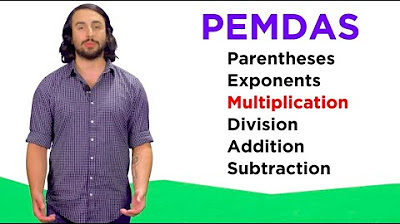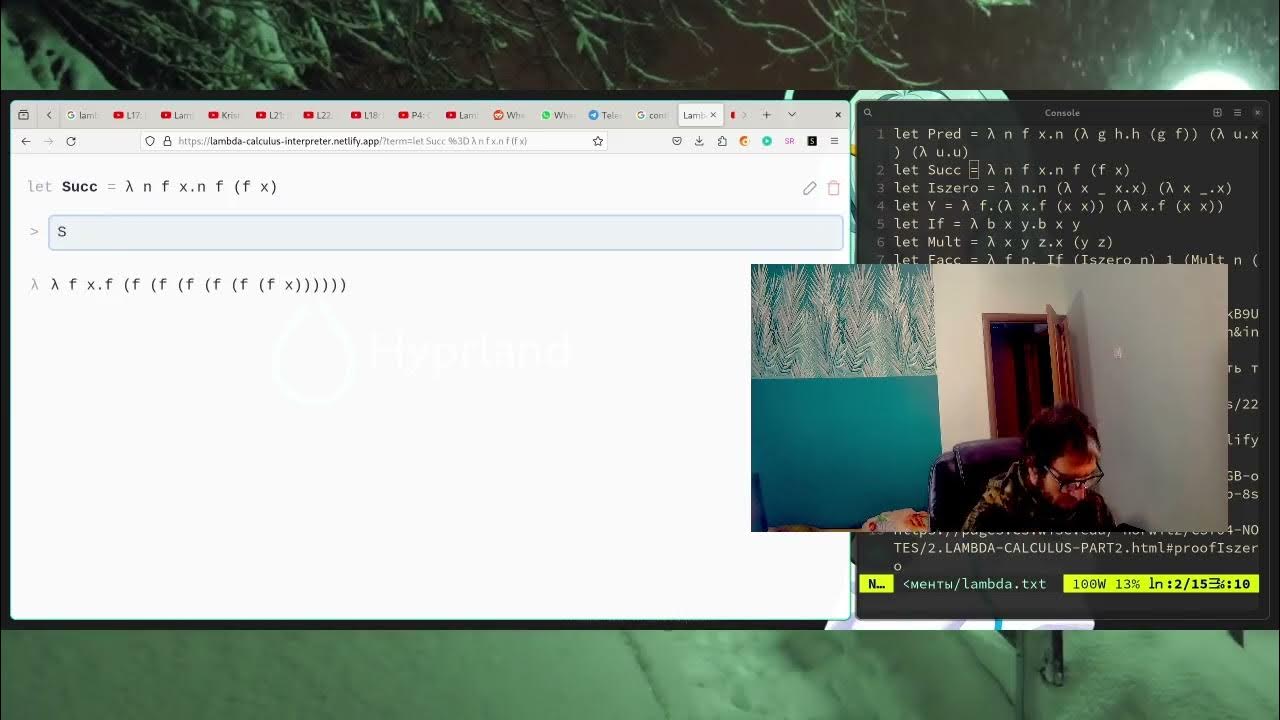lambda calculus reduction strategies
TLDRThis video script explores the reduction strategies for Lambda expressions, specifically focusing on the Church-Rosser theorem and two main evaluation strategies: applicative order and normal order evaluation. It explains how the applicative order evaluates the innermost expressions first, which may lead to infinite loops, while the normal order evaluates the outermost expressions first, guaranteeing a normal form if one exists. Examples illustrate the differences and implications of each strategy, highlighting the advantages of normal order evaluation in finding normal forms.
Takeaways
- 😀 Lambda expressions can be reduced in multiple ways due to the Churcher theorem, which states that if there are multiple paths to a normal form, the normal form is unique.
- 🔍 There are two main strategies for reducing Lambda expressions: normal order evaluation and applicative order evaluation.
- 👉 In applicative order evaluation, the leftmost innermost redex is reduced at each step, which means evaluating the argument of a function before the function itself.
- 🔄 The leftmost innermost redex is defined as the leftmost redex that does not contain any other reducible sub-expressions.
- 🔁 Applicative order evaluation can lead to infinite loops even for expressions that have a normal form, as it may fail to find the stopping point.
- 🌐 Normal order evaluation, on the other hand, always reduces the leftmost outermost redex at each step, focusing on the 'surface' of the expression.
- 🔍 The outermost redex is the one that does not contain any other redex within it, making it the most superficial part of the Lambda expression.
- 💡 Normal order evaluation is guaranteed to find the normal form if one exists, avoiding the issue of infinite loops seen in applicative order evaluation.
- 📚 Both strategies are important in understanding the computation process of Lambda expressions and their potential outcomes.
- 🔑 The choice of strategy can significantly impact the evaluation process and whether a normal form is reached or an infinite loop occurs.
- 🎓 Understanding these strategies is crucial for anyone studying or working with Lambda calculus, as it provides insight into the nature of functional programming and computation.
Q & A
What is a Lambda expression in the context of the provided script?
-A Lambda expression is a function definition in the Lambda calculus, a formal system in mathematical logic and computer science for expressing computation through function abstraction and application.
What is the significance of the Churcher theorem mentioned in the script?
-The Churcher theorem, also known as the Church-Rosser theorem or the confluence theorem, states that if a Lambda expression can be reduced to a normal form, then there is only one such normal form, regardless of the reduction path taken.
What are the two main strategies for reducing Lambda expressions as discussed in the script?
-The two main strategies for reducing Lambda expressions are normal order evaluation and applicative order evaluation.
What is the difference between normal order evaluation and applicative order evaluation?
-In normal order evaluation, the leftmost outermost redex is reduced at each step, while in applicative order evaluation, the leftmost innermost redex is reduced at each step.
What is a redex in the context of Lambda calculus?
-A redex (reducible expression) is a subexpression within a Lambda expression that can be reduced according to the rules of the Lambda calculus.
What is meant by the 'leftmost innermost redex' in the script?
-The 'leftmost innermost redex' refers to the redex that is the farthest to the left and does not contain any other reducible subexpressions within it.
What is the process of 'applicative order evaluation' as described in the script?
-Applicative order evaluation is a strategy where the argument of a function is evaluated before the function itself, by always reducing the leftmost innermost redex at each step.
Can applicative order evaluation always find the normal form of a Lambda expression?
-No, applicative order evaluation may fail to find the normal form of a Lambda expression, as it can lead to an infinite loop in some cases.
What is the process of 'normal order evaluation' as described in the script?
-Normal order evaluation is a strategy where the leftmost outermost redex is reduced at each step, which tends to evaluate the outermost parts of the expression first.
Does normal order evaluation always find the normal form if it exists?
-Yes, normal order evaluation will always find the normal form of a Lambda expression if one exists, as it ensures that all arguments are fully reduced before applying the function.
What is the significance of the 'normal form' in Lambda calculus?
-The normal form of a Lambda expression is the simplest form it can be reduced to, where no further reductions are possible. It represents the final result of the computation.
Outlines
🧠 Lambda Expression Reduction Strategies
This paragraph introduces the concept of reducing Lambda expressions and discusses the Churcher theorem, which states that all reduction paths lead to a unique normal form. It highlights two main strategies for reducing Lambda expressions: normal order evaluation and applicative order evaluation. The speaker begins by explaining applicative order evaluation, where the leftmost innermost redex (reducible expression) is reduced at each step. This method evaluates the argument of a function before the function itself. The paragraph also includes an example to illustrate how this process works, although the example is not fully clear due to some errors in the script.
🔍 Comparing Reduction Strategies in Lambda Calculus
This paragraph delves deeper into the two strategies for reducing Lambda expressions: normal order evaluation and applicative order evaluation. It contrasts the applicative order evaluation, which can lead to an infinite loop if the expression does not have a normal form, with the normal order evaluation, which always finds the normal form if one exists. The speaker explains that in normal order evaluation, the leftmost outermost redex is reduced at each step. An example is provided to demonstrate how this strategy leads to a normal form, unlike the applicative order evaluation, which might fail to do so. The paragraph concludes by emphasizing the reliability of the normal order evaluation strategy in always reaching a result.
Mindmap
Keywords
💡Lambda expression
💡Reduce
💡Churcher theorem
💡Normal form
💡Redex
💡Normal order evaluation
💡Applicative order evaluation
💡Innermost redex
💡Outermost redex
💡Infinite loop
Highlights
Lambda expressions can be reduced in various ways due to the Churcher theorem, which states that all reduction paths lead to a unique normal form.
There are two main strategies for reducing Lambda expressions: normal order evaluation and applicative order evaluation.
Applicative order evaluation involves reducing the leftmost innermost redex at each step, which is the leftmost redex not containing other redexes.
In applicative order, the argument of a function is evaluated before the function itself.
An example given demonstrates the process of applicative order evaluation, showing how it can lead to an infinite loop.
Normal order evaluation, on the other hand, reduces the leftmost outermost redex at each step, which is the redex not contained within any other redex.
Normal order evaluation is characterized by reducing the most superficial redex, akin to the surface of the Lambda expression.
A demonstration of normal order evaluation shows that it can always find the normal form if one exists, unlike applicative order evaluation.
The choice of evaluation strategy can significantly impact the outcome of a Lambda expression, with some strategies leading to infinite loops.
The concept of 'redex' is central to both evaluation strategies, referring to the part of a Lambda expression that can be reduced.
The transcript explains the difference between the 'innermost' and 'outermost' redex, which determines the order of evaluation.
The Churcher theorem guarantees the uniqueness of the normal form, regardless of the reduction path chosen.
The transcript provides a clear distinction between the two evaluation strategies, illustrating their application with examples.
The potential for infinite loops in applicative order evaluation highlights the importance of choosing the right strategy.
Normal order evaluation is presented as a more reliable strategy, always leading to a normal form if it exists.
The transcript emphasizes the theoretical underpinnings of Lambda calculus, including the concept of normal forms and reduction strategies.
Practical implications of the evaluation strategies are discussed, showing how they can affect the computational process.
The concept of 'strategy' in Lambda calculus is introduced, defining how the choice of path during reduction can influence the outcome.
The transcript concludes with a summary of the key points, reinforcing the importance of understanding different evaluation strategies in Lambda calculus.
Transcripts
5.0 / 5 (0 votes)
Thanks for rating:





